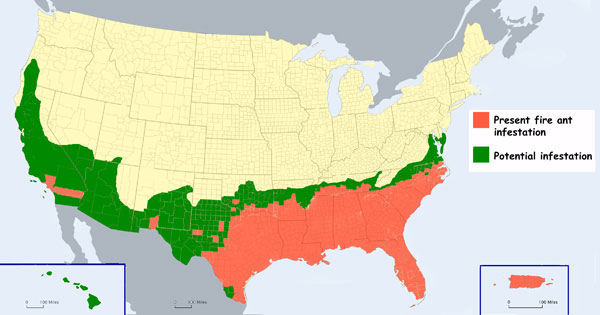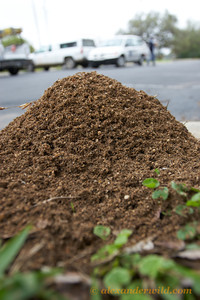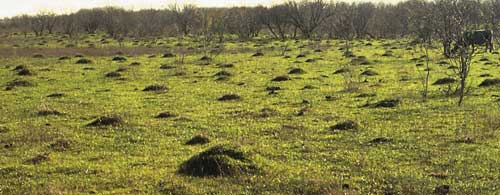Habitat
Solenopsis invicta is native to
Southwestern Brazil, Paraguay and Northern Argentina (Sutherst
and Maywald 2005). In these particular areas, the Red Imported
Fire Ant thrives in moist, protected areas, either embedded in
soil, underneath logs, or buried within the nests of other
organisms like termites (Taber 2000). What makes these ants
“invasive” is not only their ability to dominate but actually
thrive in altered habitats such as “cleared” areas brought on by
humans, an adaption that similar species are incapable of
attaining. The RIFA also do exceptionally well in extreme
habitats like, for instance, the South American rain forest
(Taber 2000).
The intrusion
of these ants to the United States was likely due to human
transport. They were unintentionally introduced into this
country over the past century as stowaways in cargo shipped from
their homeland of South America and have rapidly been spreading
throughout the southern United States ever since (Ascunce et al.
2011). Recently there has been cases where it seems that this
invasive species has been introduced to new regions like
California and other areas around the globe too. They are said
to be one of the most successf ul
and most hated invasive species of ants (Cumberland and Kirkman
2012). Models of future range expansions of the Red Imported
Fire Ant are based largely on historical temperature and
precipitation data. These models show the potential for this
species to eventually become established in over almost half of
terrestrial land masses which goes to show the versatility of
the S. invicta (Ascunce et al. 2011).
ul
and most hated invasive species of ants (Cumberland and Kirkman
2012). Models of future range expansions of the Red Imported
Fire Ant are based largely on historical temperature and
precipitation data. These models show the potential for this
species to eventually become established in over almost half of
terrestrial land masses which goes to show the versatility of
the S. invicta (Ascunce et al. 2011).
Added to
that, their adaptability is seen in the other unique habitats in
which they can be found. For instance, they are capable of
nesting indoors within drawers, boxes, walls, and underneath
rugs, bringing soil with them in all these cases (Taber 2000).
On the other hand, outdoors they are more inclined to dominate
open and disturbed areas, particularly soil disturbances created
by human actions. Areas such as roadsides, cultivated fields,
and lawns make great homes for these ants (Cumberland and
Kirkman 2012). Pastures are a favorite target for newly mated
RIFA queens. In fact, pastures in Georgia average about 27
colonies per acre of land (Taber 2000).
On e of their
most distinguishing features is their nest which begins with
mated RIFA queens who begin by digging a vertical tunnel in the
soil to a depth of about three inches. Within about one day, the
entrance will close from the inside and the queen(s) will start
laying their eggs in isolation. Surprisingly, in about three
years mounds can grow to about one foot high and two feet wide
at the base. Most nests contain a mound that is the above ground
portion of the nest that allows each offspring to be moved about
in order to track temperature and humidity suitable for their
development. The size, the shape, and the internal framework
habitually depend upon the soil type and the vegetation in the
surrounding area. Over time, a hard outer crust will encase the
structure and tunnels and passageways will occupy more than half
of the total volume of the mound. Certain colonies are called
“polydomic” or “polycalic” because they have more than one mound
(monodomic). Each RIFA mound will have several main, horizontal
tunnels diverging about one hundred feet into the surrounding
area. Each main, horizontal branch will divide into smaller side
branches with openings reaching the soil surface. Vertical
tunnels are found inside as well, some of which extend about six
feet or more into the water table. In general, mounds in the
United States are built on a smaller scale, one fourth of which
are found to be abandoned. In Brazil, mounds tend to be smaller
in the dry season and larger in the wet season. Often if the
heat is too intense, the temperature too high, mounds can be
entirely absent because ant are able to cool off by retreating
to the depths of the soil underneath. By doing this, they are
unable to maintain the structure (Taber 2000).
e of their
most distinguishing features is their nest which begins with
mated RIFA queens who begin by digging a vertical tunnel in the
soil to a depth of about three inches. Within about one day, the
entrance will close from the inside and the queen(s) will start
laying their eggs in isolation. Surprisingly, in about three
years mounds can grow to about one foot high and two feet wide
at the base. Most nests contain a mound that is the above ground
portion of the nest that allows each offspring to be moved about
in order to track temperature and humidity suitable for their
development. The size, the shape, and the internal framework
habitually depend upon the soil type and the vegetation in the
surrounding area. Over time, a hard outer crust will encase the
structure and tunnels and passageways will occupy more than half
of the total volume of the mound. Certain colonies are called
“polydomic” or “polycalic” because they have more than one mound
(monodomic). Each RIFA mound will have several main, horizontal
tunnels diverging about one hundred feet into the surrounding
area. Each main, horizontal branch will divide into smaller side
branches with openings reaching the soil surface. Vertical
tunnels are found inside as well, some of which extend about six
feet or more into the water table. In general, mounds in the
United States are built on a smaller scale, one fourth of which
are found to be abandoned. In Brazil, mounds tend to be smaller
in the dry season and larger in the wet season. Often if the
heat is too intense, the temperature too high, mounds can be
entirely absent because ant are able to cool off by retreating
to the depths of the soil underneath. By doing this, they are
unable to maintain the structure (Taber 2000).

The amazing resilience of this species of ants makes them a very unique species to learn about. S. invicta have evolved many adaptations that have helped them become a versatile species. To learn more about these modifications check out our adaptations page.
Click here to return to the home page.
